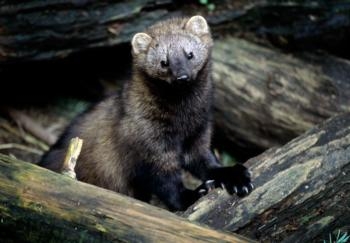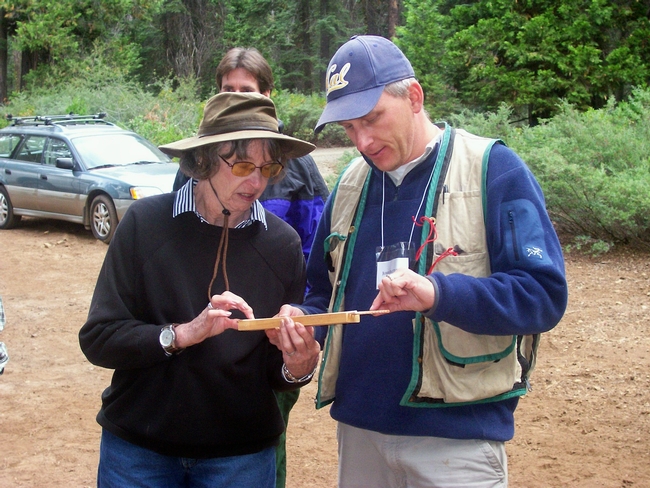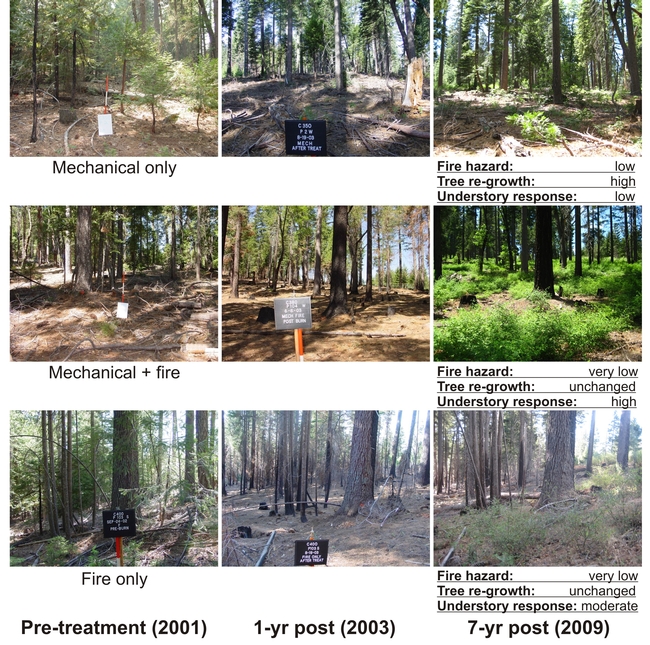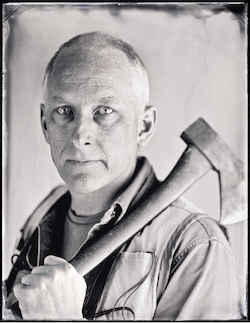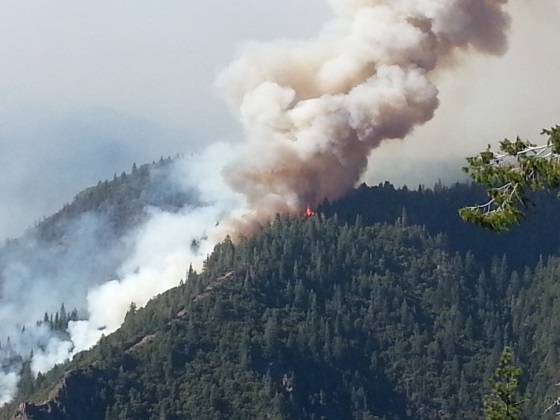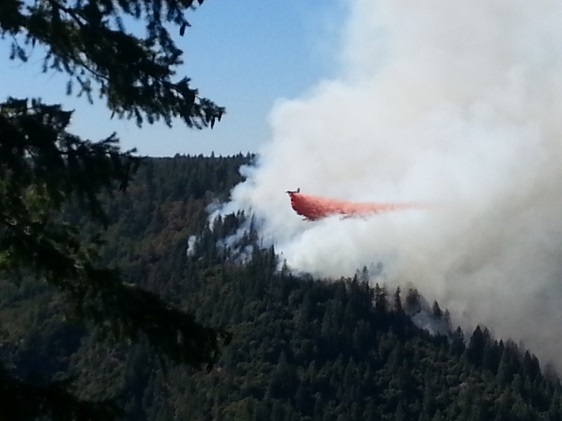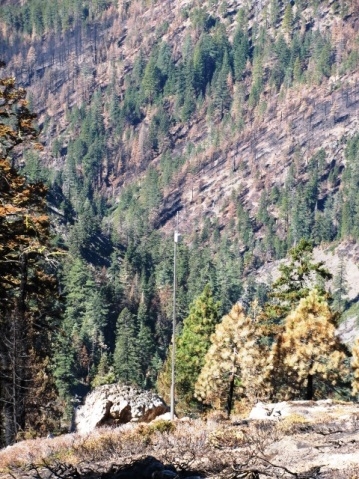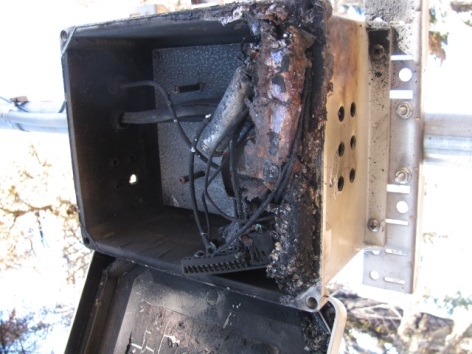Posts Tagged: SNAMP
Rat poison used in marijuana grows harming wildlife
Post-mortem tests on Pacific fishers that are part of an extensive UC study have determined that most had a significant amount of rodenticide in their bodies when they died, reported Kellie Flanagan in the Sierra News Online.
The fishers are being monitored by a team of scientists affiliated with the Sierra Nevada Adaptive Management Project (SNAMP), a joint effort by the University of California, state and federal agencies and the public to study management of forest lands in the Sierra Nevada.
To learn the animals' habits and habitat, the SNAMP wildlife team has placed radio-tracking collars on about 100 fishers over the years, with around 30 collared at any given time. When animals being monitored die, they are collected to determine the cause. Anti-coagulants were found in the livers of 90 percent of the fishers.
A likely source is rodenticides left behind at illegal marijuana grows in the forest, the article said.
"SNAMP discovered the rodenticide poisoning issue in the fisher population, and we knew we needed to find some money to clean up the raided sites," said Anne Lombardo, SNAMP representative based in Oakhurst, Calif. "That's our contribution to putting science on the ground."
Nov. 5 - 14 about 100 volunteers and agency personnel cleaned up 13 Sierra Nevada marijuana cultivation sites to restore habitat, and remove risks to wildlife. The teams dismantled and remediated sites previously raided or partially cleaned up, and documented and removed all toxicants found.
The effects of density and high severity fire on tree and forest health
Hike off-trail through most any part of the Sierra Nevada and you may find yourself losing your hat to a low hanging branch, your shoe to a thicket of dead and dying brush, or your companion to the crevice hidden by the wall of young trees.
There is no doubt that the forests of the Sierra Nevada, while amazingly beautiful, have grown dense with vegetation. Consequently, forests have become increasingly susceptible to high severity fires, which negatively impact the forest's overall health and our ability to enjoy it.
There is a relationship between a healthy forest and its density. The denser the forest, the more competition individual trees have for valuable resources, such as water, light and nutrients. The effects of competition on tree growth and death are profound – the more trees per acre, the smaller the diameter of the individual trees (meaning less growth) and the higher the likelihood trees will be negatively impacted by pests, diseases, and poor health, ultimately leading to tree mortality. Theories in ecology, supported by field data and statistical analysis, predict that some trees will outperform others and the difference in performance increases with crowding. Unfortunately, evidence suggests that excess density is causing increased mortality in the Sierra.
John Battles, forestry professor at UC Berkeley and member of the Sierra Nevada Adaptive Management Project (SNAMP), is leading a team of UC Berkeley researchers and graduate students in developing vulnerability profiles that will help to quantify individual trees' probability of survival. The growth response of individual trees is the primary measure of forest health in the SNAMP study. The team believes growth is an excellent indicator of tree vitality and that a necessary (but not sufficient) condition for a healthy forest is healthy trees.
The team collected and processed more than 12,000 tree cores to develop long term growth and vulnerability profiles for different tree species. Their results supported the accepted notion that, in general, good growth was an indicator of good health. However, they also found that "bad years," when growth was substantially lower than normal, were strong predictors of death. In addition, they reported that bad years had a cumulative impact that spanned decades. In other words, the best predictor of potential death was for a tree to experience two or more bad years over the most recent 20 – or even 40 – years. The team has been working to translate these relationships between tree growth and survival to produce a vulnerability index by species and size. One goal is to have some sense on how vulnerable a stand is before many trees start to die.
Another key question being asked by SNAMP researchers is whether fuels treatment projects designed to modify fire behavior also improve forest health. Battles and his team hypothesize that thinning a dense forest will improve individual tree and overall forest health, as well as reducing fire risk. Resilience, or the capacity to recover from adverse conditions, is the goal. Histories captured in tree core samples show that trees can survive adverse conditions such as fire and drought. While studies have shown that properly implemented fuel treatments are effective at reducing hazardous fire potential, there are secondary ecological effects that can impact forest resilience either positively or negatively depending on the treatment type, timing and intensity. In a study at the UC Blodgett Forest Research Station, researcher Brandon Collins and others looked at large, dominant tree growth responses, measured seven years after the implementation of some of the most common fuel treatments, to estimate that forest's health. Across the five tree species analyzed, observed mortality and future vulnerability were consistently low in the areas where only mechanical treatment occurred. Fire-only treatment had results similar to areas that did not receive treatments for all species except Douglas-fir. Mechanical-plus-fire treatments, however, had high observed mortality and future vulnerability for white fir and sugarpine. Given that these large, dominant trees play a key role in terms of wildlife habitat, carbon sequestration and soil stability, these results have implications for understanding longer-term impacts of common fuel treatment types on forest resilience.
Through the analysis of tree core samples, Battles and his team hope to provide clarification on conditions that improve individual tree health and the overall health of the forest. The final report on SNAMP, with the results of the forest health study described here, will be available May 31, 2015, at http://snamp.cnr.berkeley.edu/.
Taming Sierra flames
A UC team tamps down fire danger and finds common ground
The summer of 2002 was a bad fire season in the United States. Twice as many acres burned than in 2001, and more total acres were destroyed than in all but one of the previous 40 years. The McNally Fire in Sequoia National Forest was only the second largest fire in California that year, and it alone cost more than $50 million to extinguish. It was against this smoky backdrop that George W. Bush launched the Healthy Forests Initiative, a wide-ranging plan to reduce the severity of western wildfires.
In California, the plan coalesced around the concept of strategically placed landscape treatments, colorfully shortened to SPLATs. Mark Finney, a researcher at the Missoula Fire Lab in Montana, proposed that instead of thinning entire old growth forests, land managers could “treat” a fraction of the land with tree thinning and prescribed burns. These treated plots would slow a fire's rate of spread, acting like speed bumps along a road.
It was an interesting but untested idea, and by 2004 the plan ran into bureaucratic roadblocks. Because, while the federal government owns the national forests, the old-growth dwelling wildlife — fishers, goshawks, spotted owls — can fall under state or federal management, depending on the species. Closer to the action, the local communities of Foresthill and Oakhurst were concerned about large-diameter trees being cut as part of the thinning effort, and about the effect of prescribed burning on issues like home safety, wildlife and water quality.
It was beginning to look like then-Governor Arnold Schwarzenegger, a Republican and a self-professed environmentalist, was going to sue the Bush administration over its forest policy mandates — an expensive, bitter process that nobody relished. Instead, a novel approach was conceived: The U.S. Forest Service agreed to test the unproven SPLAT approach along with state agencies, like Fish and Game, Department of Water Resources, and Cal Fire, as long as a neutral third party could be tasked with analyzing the results. And that third party would be the University of California.
And thus, the Sierra Nevada Adaptive Management Project was born, with another endearing acronym, SNAMP. Today, as SNAMP reaches the end of a 10-year run, the project has proven to be a multidisciplinary, multiagency, multimedia success that has the potential to transform not only how we view forest fires, but more intriguingly, how scientists, government agencies, and public stakeholders interact in the pursuit of common goals.
Gradually, a plan took shape. With the ultimate goal of moderating fire behavior, the U.S. Forest Service would conduct prescribed burning and tree thinning as they saw fit. It would then be up to UC scientists to study the results — not just in terms of fire, but also the impact on wildlife, water and forest health.
Working with stakeholders
Modern adaptive management takes into account complex factors — climate change, human impact, a century of fire suppression, marijuana farms on federal lands — requiring forest managers to continually adapt their strategies to new information, new methods, and new facts on the ground. Even so, a traditional study of various fire treatments would have been fairly straightforward: Do a range of experiments, analyze the results, publish some papers.
But SNAMP's goals went far beyond simply figuring out the best way to slow a wildfire's spread. The experiment proceeded along parallel tracks, studying fire, forest health, fishers, owls, water quality issues and spatial data. And crucially, public participation wasn't an afterthought or an also-ran, but the key piece of the puzzle. According to Kim Rodrigues, a UC Cooperative Extension regional director at the time, “The overall goals of public participation are efforts to reduce conflicts around resource management on the ground.” Rodrigues focused on figuring out how to make public participation more meaningful and relevant.
How to best engage the public was an open question. The team eventually settled on a simple strategy: try everything. Kelly and others created a comprehensive, interactive website stuffed with videos, summaries of scientific findings, and a huge trove of documents available for scientists, agency employees, and any member of the general public who took an interest. Perhaps the best feature was the discussion section, where people submitted questions about topics as varied as fuel break maintenance, government intrusion onto private lands, and the affects of the Native American practice of gathering pine roots. The questions received thorough responses from the team members, a level of public engagement that's truly unusual for scientists who are more accustomed to responding only to peer reviewers.
The website was moderately successful. “But our stakeholders really prefer face to face,” says Kelly, so her team ramped up its in-person efforts. Extension agents who lived in the affected communities of Oakdale and Auburn made themselves available for public questions and concerns at board of supervisors meetings, PTA gatherings, and fire-safe councils. Beyond the standard bad-coffee talkathons, the scientists also held field trips to show these theoretical issues in action.
“Anyone can talk about ‘resilient forests,'” Rodrigues says, “but if you go to the Rim Fire [the massive 2013 Yosemite blaze] you can operationalize these terms. You can show someone that this is how a high-severity fire sterilizes the soil.” And the learning went both ways, according to Lynn Huntsinger, professor in the Department of ESPM at Berkeley, who was recruited by Battles for her experience working with landowners. “I've seen management programs in the past where scientists don't come to meetings and face stakeholders,” she says. “But in this case, the stakeholders ended up influencing the kinds of research questions that the scientists asked.”
Adapted from an article Breakthroughs Magazine. Read the complete story in here.
Tintype photography by Michael Shindler
What happens when a wildfire sweeps through your study area?
On Aug. 10, 2013, a wildfire started in a steep canyon on the Tahoe National Forest. When it was finally declared controlled on Oct. 8, the 'American Fire' as it was named, had burned approximately 27,440 acres, including half (1,100 acres) of the Sierra Nevada Adaptive Management Project (SNAMP) Last Chance study site.
Initiated more than 7 years ago, SNAMP is a collaboration project involving the University of California, UC Cooperative Extension, the US Forest Service, other state and federal agencies and the public that explores the effects of fuels reduction or thinning projects conducted by the Forest Service on forest health, fire behavior, water quality and quantity, wildlife (California spotted owl and Pacific fisher) and public participation. Scientists are using data collected from treated and untreated areas to model potential impacts of forest management. For example, fire modeling is being done to simulate what could happen in the event of a fire on the landscape. All of the science teams are integrating their results to provide forest managers with information that is relevant at the fireshed scale for future projects.
Before the American Fire broke out, work by the Forest Service on the Last Chance project treatment areas was mostly completed, including commercial timber harvesting, post-harvest surface fuels treatment and more than three-quarters of the prescribed fire acreage. UC forest researchers had resurveyed 99 percent of treated and untreated forest plots and were out in the forest working to complete the remaining plots when the fire started. The owl team had completed their surveys for the year at Last Chance and in the surrounding areas that comprise the regional study areas. The water team had in-stream monitoring equipment in place, as well as meteorological stations at several locations, recording and relaying data to UC Merced.
After the American Fire ignited west of the SNAMP study site, American River Ranger District staff ordered all science teams working in the area to evacuate. They removed several of the water team's wireless nodes that were threatened, along with the stream level monitoring equipment. They covered other equipment with fire blankets and bulldozed a defensive line around a meteorological station to keep the fire out of the immediate area.
Parts of the treated and untreated study areas in the Last Chance project, including completed thinning and prescribed burning units, were burned in the American Fire. Some of this area was intentionally backfired by firefighters to aid in fire management. The vast majority of the treated area burned at low severity with pockets of moderate severity. The decision to backfire through the middle of the Last Chance project was a direct result of the project's location and post-treatment fuel profile.
The final determination of how the vegetation survived the fire will probably not be made for another year since significant mortality can happen much later. There was one active spotted owl nest site on the fire perimeter and it was known to have juvenile owls. The site will be surveyed by the owl team in 2014. As a result of quick action by the US Forest Service, only one of the water team's wireless nodes was damaged by fire.
The SNAMP project comes to an end this year. Science teams are working with post-treatment but pre-fire data to complete their analysis, write individual chapters and create integration products. However at the same time, the American Fire provides a unique but fleeting opportunity to empirically examine the effects of fuels treatments. Thus planning is underway for further research at Last Chance to examine how wildfire under current management can transform ecosystem functions, and how to obtain desired results through novel fire management strategies. Adaptive management is analysis of an action, incorporation of new findings and adapting existing actions based on those results. SNAMP scientists want to take full advantage of the learning opportunities provided by the investment in SNAMP and the impacts of the American Fire at Last Chance.
Generating energy from forest products
Thinning a forest of woody materials has multiple objectives. It can increase the resiliency of the remaining trees from the effects of fire, drought, pest and disease; it can improve habitat quality for wildlife including watersheds; and it can make it easier for firefighters to protect human lives and livelihoods when a fire is burning. There are several ways thinning is carried out: cable logging, feller bunching, conventional tractor skidding, hand-thinning and piling, and mastication. One of the issues with thinning is the disposal of biomass that is non-merchantable (e.g., branches, tree tops, small diameter trees). Typically this material goes into large slash piles. For the most part, these piles are left in the forest to break down naturally under winter rain and snows, and are later burned. Because of strict air quality rules, forest managers have very small windows of opportunity to burn these piles, so they are often left on the landscape for many years, sometimes becoming a fire hazard themselves.
Forested communities are searching for ways to deal with this residual biomass that will improve the health of the forest ecosystem; improve and protect critical watersheds and wildlife habitat; reduce the amount of air pollution by removing the piles instead of burning them; and reduce the critical fire danger to their communities. The Placer County Biomass Program is taking up this challenge by chipping the slash piles and trucking the chips to a biomass facility to be converted into electricity.
Outside of Foresthill, Calif., the Tahoe National Forest American River Ranger District and the Sierra Nevada Adaptive Management Project (SNAMP) have been collaborating on a study of forest fuels reduction treatments carried out on national forests. The eight-year ‘Last Chance’ study involves independent third party research by University of California scientists of the integrated effects of forest thinning on fire hazard, forest health, wildlife, water quality and quantity, and public participation. The Placer County Biomass Program, in conjunction with the Tahoe National Forest, the Sierra Nevada Conservancy (SNC) and the Placer County Air Pollution Control District, proposes to remove some of the biomass waste from the Last Chance project to provide an alternative to open burning of the piles. Local contractors are hired to grind the material on-site, load the material into chip vans, and bring the material to market within 60 miles of the Last Chance site to create green, renewable electricity. Placer County estimates that roughly 3,000 Bone Dry Tons (BDTs) of biomass can be removed. According to UC researchers, one BDT burned in a typical commercial boiler fuel will produce 10,000 pounds of steam and 10,000 pounds of steam will produce about 1,000 horsepower or generate 1 megawatt hour (MWH) of electricity.
The economics of this project will be used as part of the assessment of locating a biomass energy facility in the Foresthill area. The removal of these biomass piles will greatly reduce the possibility of catastrophic fire to the local communities on the Foresthill Divide. The improved forest and watershed health will be noticed by the local community and the surrounding county which derives recreation and watershed benefits from the American River area. In addition, several tons of air pollutants will be avoided by removing the pile burns from this area which is currently a federal non-attainment basin that carries both business and health risks to the local population.
Though this project is of benefit to the Foresthill community, other communities in the wild-land urban interface aren’t as lucky. According to Brandon Collins, research scientist at the Pacific Southwest Research Station and UC Berkeley, the lack of funding to chip and remove slash piles and the lack of infrastructure or facilities to take the chips to, makes it impossible at this time to remove that biomass at a larger scale.
“There is so much woody material on the landscape as a result of fire exclusion, it could take decades to really get a handle on it," Collins said. "However, any effort to remove thinning residues from the forest and to also get a benefit from it, such as energy, is great and should be supported.”
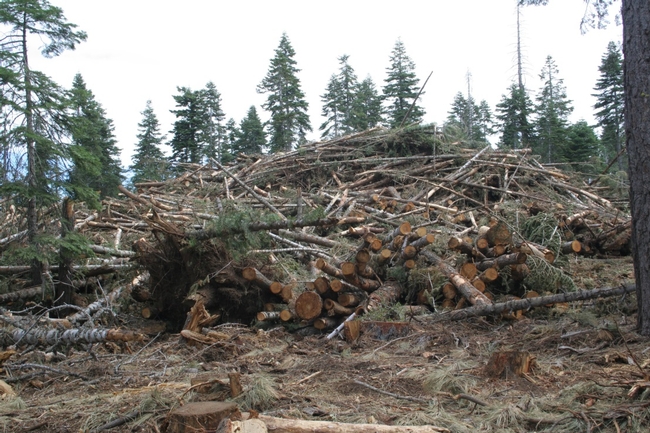
Slash pile in Tahoe National Forest, Last Chance project.
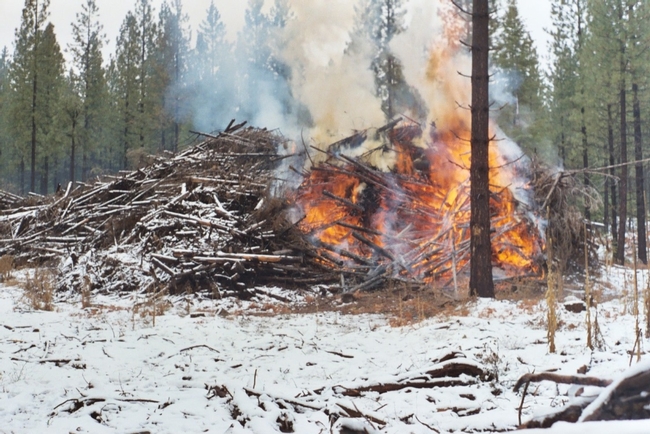
Slash pile under a controlled burn.
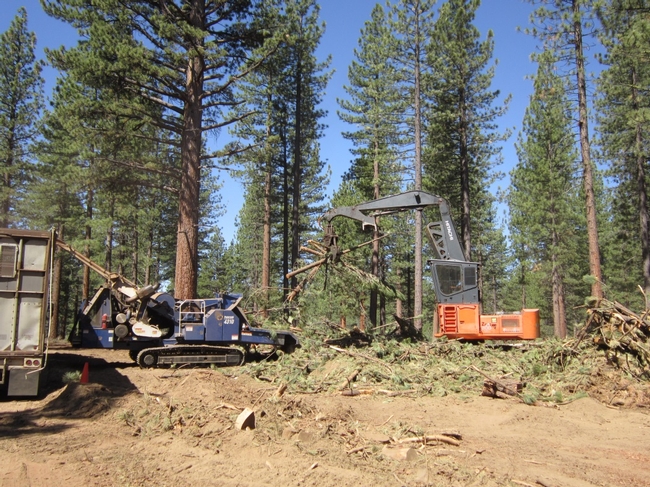
Workers bunch slash.
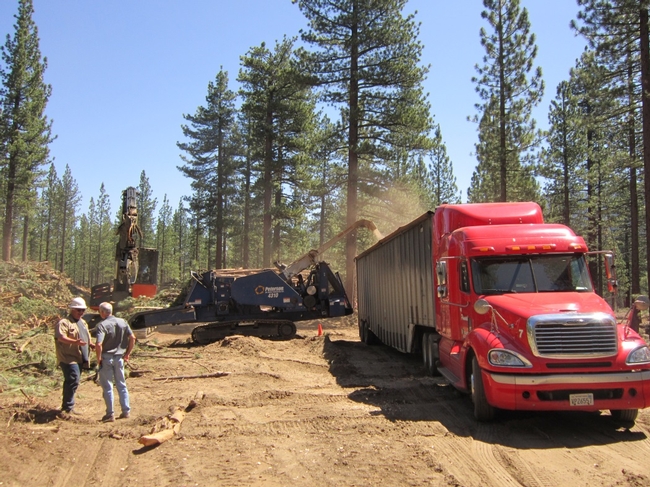
Slash piles are chipped and trucked to biomass facility.


